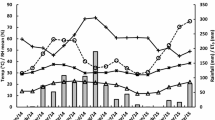Abstract
Sugarcane growers in Mauritius are using mechanized harvesting to reduce costs. This practice results in a trash blanket which contributes to conserve soil moisture, but potential savings in irrigation water have yet to be quantified. An on-farm study was undertaken at three sites in the irrigated coastal zone of Mauritius under sub-humid to humid mega-thermal climate and soils that were oxisol or inceptisol. Trials were conducted in ratoon crops under centre pivot irrigation and treatments with or without trash blanket, as well as different irrigation regimes. Sensors were used to log soil moisture data at 20, 40 and 60 cm depths. Increased drainage was observed under trash blanket during rainfall events and cumulative drainage for a 4-month wet period amounted to 43 and 240 mm for no-trash and trash blanket treatments respectively. Daily crop water use was higher with trash blanket, consumption being 4.9 and 5.1 mm day−1 compared to 4.2 and 4.6 mm day−1 for no-trash during peak growth at Savannah and Médine. Sugarcane yield was higher by 7.2 and 6.6 t ha−1 year−1 with trash blanket compared to no-trash, whereas water use efficiency increased by 8 and 9 kg ha−1 mm−1. At Saint Antoine, trash blanket increased the yield difference between irrigated and rainfed crops by 8.6 t ha−1 and improved water use efficiency by 7 kg ha−1 mm−1 when irrigated. Seasonal water equivalence of the trash blanket amounted to 62, 54 and 72 mm water at Savannah, Médine and Saint Antoine, a potential saving of 10–15 % in irrigation water.






Similar content being viewed by others
References
Anonymous. 2011. Monthly bulletin of climatological summaries. Meteorological Services, Vacoas, Republic of Mauritius.
Chan, P.Y., and L. Li Pi Shan. 1975. Some soil moisture data and their application to irrigation of sugar cane. Revue Agricole et Sucrière de l’Ile Maurice 54: 115–119.
Chapman, L.S., P.L. Larsen, and J. Jackson. 2001. Trash conservation increases cane yield in the Mackay district. Proceedings of the Australian Society of Sugar Cane Technologists 23: 176–184.
Denmead, O.T., C.L. Mayocchi, and F.X. Dunin. 1997. Does green cane harvesting conserve soil water? Proceedings of the Australian Society of Sugar Cane Technologists 18: 139–146.
Government of Mauritius. 2006. Mauritius-EC multiannual adaptation strategy. EU—Mauritius Country Strategy Paper 2008—2013, Annex 9.
Halais, P., and E.J. Davy. 1969. Notes on the 1:100,000 Agro-climatic Map of Mauritius. MSIRI Occasional Paper No. 23, MSIRI, Réduit.
Haynes, R.J., and C.S. Hamilton. 1999. Effects of sugarcane production on soil quality: a synthesis of world literature. Proceedings of the South African Sugar Technologists’ Association 73: 46–52.
Hershfield, D.M. 1964. Effective rainfall and irrigation water requirement. Journal of Irrigation and Drainage Division ASCE 90: IR2: 3920: 33–47.
Lecler, N.L., F.C. Olivier, and M. Jones. 2009. Economic analysis of harvesting burnt versus green cane under irrigated conditions. Proceedings of the South African Sugar Technologists Association 82: 613–617.
Little, T.M., and F.J. Hills. 1978. Agricultural Experimentation—Design & Analysis. Toronto: Wiley.
Meier, E.A., P.J. Thorburn, M.K. Wegener, and K.E. Bosford. 2002. A conceptual analysis of nitrogen from trash blankets in the wet tropics. Sugar Cane International May/June 2002: 8–11.
MSIRI. 2003. Mauritius sugar industry research institute annual report 2002. Réduit: MSIRI.
MSIRI. 2012. Mauritius sugar industry research institute annual report 2011. Réduit: MSIRI.
Mualem, Y. 1976. A new model predicting the hydraulic conductivity of unsaturated porous media. Water Resources Research 12: 513–522.
Núñez, O., and E. Spaans. 2008. Evaluation of green-cane harvesting and crop management with a trash blanket. Sugar Tech 10: 29–35.
Olivier, F.C., and A. Singels. 2007. Effect of a trash blanket on irrigation water use efficiency of sugarcane. Proceedings of the International Society of Sugar Cane Technologists 26: 404–408.
Parish, D.H., and S.M. Feillafé. 1965. Notes on the 1:100,000 Soil Map of Mauritius. MSIRI Occasional Paper No. 22, MSIRI, Réduit.
Robertson, F.A., and P.J. Thorburn. 2007. Management of sugarcane harvest residues: consequences for soil carbon and nitrogen. Soil Research 45: 13–23.
Sampietro, D.A., and M.A. Vattuone. 2006. Nature of the interference mechanism of sugarcane (Saccharum officinarum L.) straw. Plant and Soil 280: 157–169.
Schaap, M.G., F.J. Leij, and MTh Van Genuchten. 2001. ROSETTA: A computer program for estimating soil hydraulic parameters with hierarchical pedotransfer functions. Journal of Hydrology 251: 163–176.
Seeruttun, S., G. McIntyre, and C. Barbe. 1992. Agronomic and economic significance of trash blanketing in the sub-humid areas of Mauritius. Revue Agricole et Sucrière de l’Ile Maurice 71: 324–331.
Seeruttun, S., C. Barbe, and G. McIntyre. 1998. Le paillis complet dans la canne à sucre en zone à forte pluviosité. Revue Agricole et Sucrière de l’Ile Maurice 77: 42–49.
Soil Survey Staff. 1999. Soil taxonomy: a basic system of soil classification for making and interpreting soil surveys. Agricultural handbook 436. Washington, DC: USDA-NRCS.
Thompson, G.D. 1976. Water use by sugarcane. South African Sugar Journal 60(593–600): 627–635.
Van Genuchten, MTh. 1980. A closed-form equation for predicting the hydraulic conductivity of unsaturated soils. Soil Science Society of America Journal 44: 892–898.
Yadav, R.L. 1986. Water management in sugarcane. Indian Sugar Crops Journal 12: 1–4.
Acknowledgments
The collaboration of the management and field staff at Savannah, Médine and Saint Antoine is gratefully acknowledged. Thanks are also due to Mr. K. Rummun and Mr. S. Soyfoo for their contribution to field work and data processing.
Author information
Authors and Affiliations
Corresponding author
Rights and permissions
About this article
Cite this article
Ng Cheong, L.R., Teeluck, M. The Practice of Green Cane Trash Blanketing in the Irrigated Zone of Mauritius: Effects on Soil Moisture and Water Use Efficiency of Sugarcane. Sugar Tech 18, 124–133 (2016). https://doi.org/10.1007/s12355-015-0374-1
Received:
Accepted:
Published:
Issue Date:
DOI: https://doi.org/10.1007/s12355-015-0374-1




